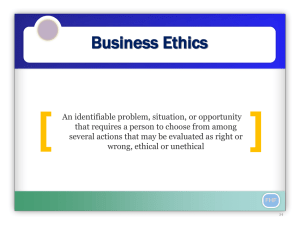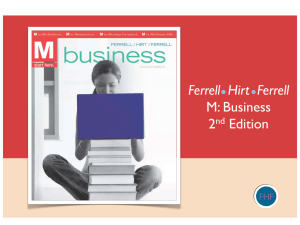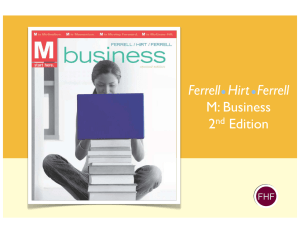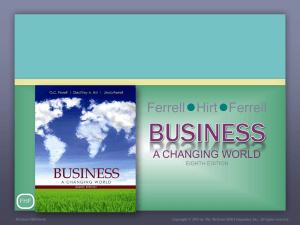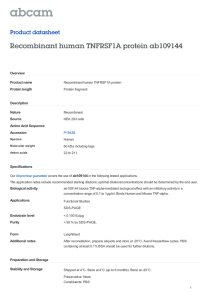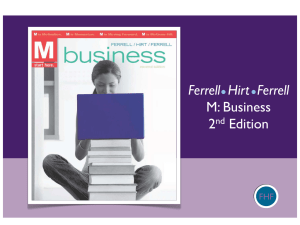Ferrell Hirt Ferrell M: Business 2 Edition
advertisement
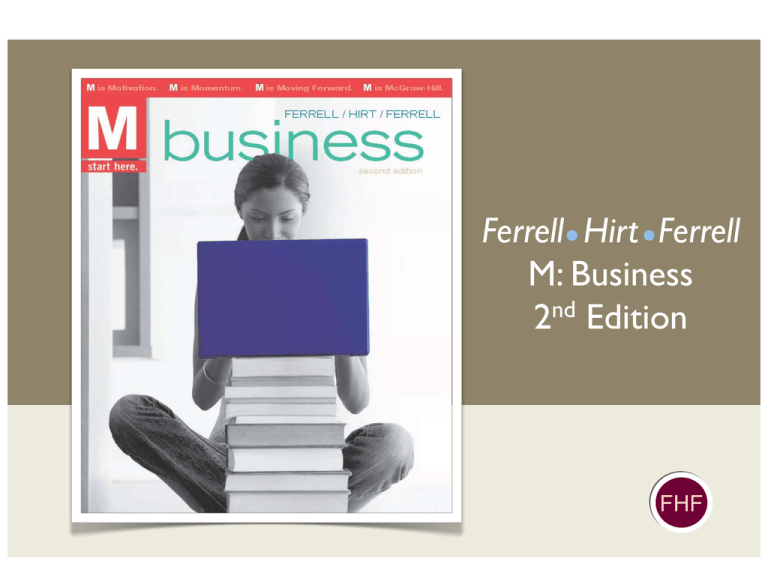
Ferrell Hirt Ferrell M: Business nd 2 Edition FHF Small Business, Entrepreneurship, and Franchising FHF McGraw-Hill/Irwin Copyright © 2011 by the McGraw-Hill Companies, Inc. All rights reserved. Entrepreneurship [ The process of creating and managing a business to achieved desired objectives ] -this is a working definition FHF 6-3 The World’s Wealthiest People FHF Source: “The World’s Billionaires, 2009,” Forbes 6-4 What is Small Business? • “Smallness” is relative. • Small business is any independently owned and operated business, not dominant in its competitive area • Employs less than 500 people. FHF 6-5 Supporting Small Businesses • The Small Business Administration(SBA) is an independent agency of the federal government that offers managerial and financial assistance to small businesses. FHF 6-6 Impact of Small Businesses FHF 6-7 Small Businesses Represent: • 60-80% of all new jobs, annually, created in the last 10 years • 66% of the economy • Employ 70% of workforce FHF 6-8 What People in the US Say is Their Idea of the American Dream Source: “USA Today Snapshots,” USA Today, April 2, 2009, A1. FHF 6-9 Small Business Innovation Small businesses represent 55% of all innovations • Airplane • Audio tape recorder • Double-knit fabric • Fiber-optic examining equipment • Heart valve • Optical scanner • Personal computer • Soft contact lenses • Zipper Product customization is an advantage of small businesses FHF 6-10 Popular Areas for Small Business • Retailing and wholesaling, services, manufacturing and high technology are especially attractive to entrepreneurs. FHF 6-11 FHF Traits needed to Succeed in Entrepreneurship 6-12 Retailing and Wholesaling Selling directly to consumers • Music stores • Sporting-goods shops • Dry cleaners • Boutiques • Drugstores • Restaurants • Hardware stores FHF 6-13 FHF 6-14 High Technology • Businesses that depend heavily on advanced scientific and engineering knowledge. • 39% of high-tech jobs are in small businesses FHF 6-15 Small Business Ownership Advantages Disadvantages • Costs • High stress level • Flexibility • High failure rate • Focus • 90% of all new businesses fail • Reputation within the first 5 years • Undercapitalization • Lack of funds to operate normally • Managerial inexperience or incompetence • Inability to cope with growth FHF 6-16 Top 5 Biggest Challenges, Concerns & Goals of Small Businesses FHF 6-17 Starting a Business • Start with a concept or general idea • Devise a strategy to guide planning & development • Make decisions • Form of ownership • Financial resources needed • Acquire existing business • Start a new business • Buy a franchise FHF 6-18 The Business Plan A precise statement of the rationale for the business and a step-by-step explanation of how it will achieve its goals. Acts as a guide and reference document. • Explanation of the business • Analysis of competition • Income/Expense estimates FHF 6-19 Forms of Business Ownership • Sole Proprietorship • Partnership • Corporation FHF 6-20 Financial Resources Provide your own personal capital • Cash money Obtain capital • Financing options loans stocks equity FHF 6-21 Equity Financing [ Selling or borrowing against the value of an asset (automobile, insurance policy, savings account) to obtain funds to operate a business Equity Financing ] FHF 6-22 Equity Financing [ Persons/organizations that agree to provide funding for a new business in exchange for an ownership interest or stock. Usually requires a sharing of ownership/control ] FHF 6-23 Debt Financing [ Borrowing financial resources typically from a bank or lending institution The Small Business Administration offers financial assistance to qualifying businesses ] FHF 6-24 Line of Credit [ An agreement by which a financial institution promises to lend a business a predetermined sum on demand ] FHF 6-25 Franchising A license to sell another’s products or to use another’s name in business, or both • Franchiser • The company that sells a franchise • Franchisee • The purchaser of a franchise FHF 6-26 Franchises Advantages Disadvantages • Training & support • Fees and profit sharing • Brand name appeal • Standardized operations • National advertising • Restrictions on purchasing • Financial assistance • Limited product line • Proven products • Possible market saturation • Greater chance for • Less freedom in decisions success FHF 6-27 FHF Fastest Growing Franchises 6-28 Going Green Green/sustainable products represent a significant business opportunity for many small businesses • Entrepreneur Kyle Berner works with Thai families to manufacture Feelgoodz Fair Trade flip-flops • 1,000% increase in sales over first year • Eco-friendly and100% natural • Moving into West Indies and South American markets FHF 6-29 The Future for Small Business Demographic Trends • The Boomers • Generation Y • Millennials • Immigrants FHF 6-30 The Future for Small Business (continued) Technological & Economic Trends • Internet usage continues to increase • Increase in service exports • Economic turbulence • Deregulation of the energy market & alternative fuels FHF 6-31 Top Cities for Entrepreneurs Source: “Hot Cities for Entrepreneurs,” Entrepreneur. FHF 6-32 Big Businesses Acting Small Common Approaches • Large firms emulate smaller ones to improve bottom line • Downsizing or rightsizing • Acting small from inception – Southwest Airlines Intrapreneurs • Individuals in large firms who take responsibility for the development of innovations within the organization FHF 6-33 FHF 6-34
